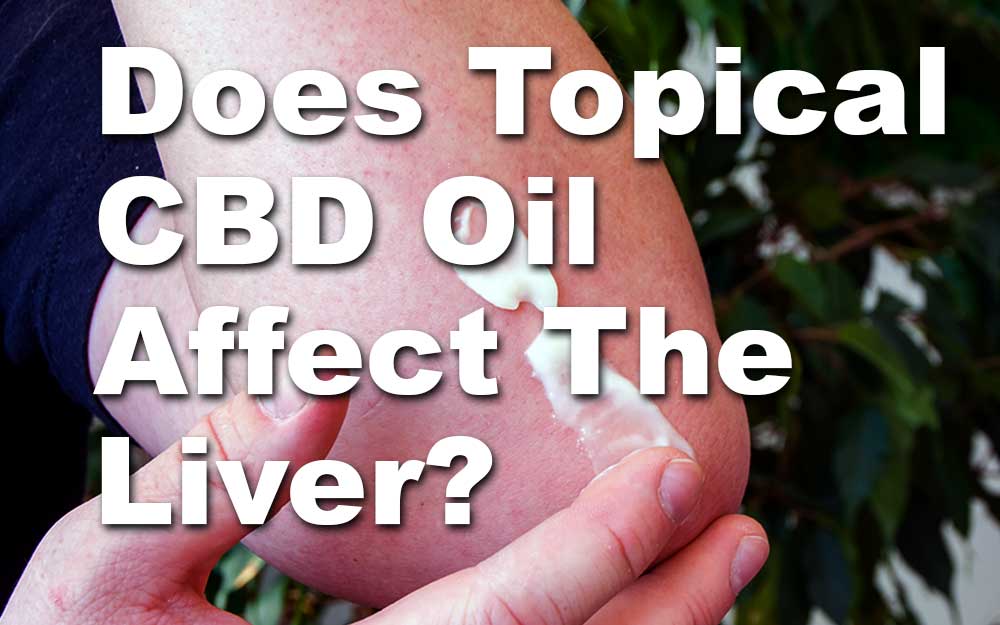Topical CBD cream skips the first stage of liver metabolism, however, a certain amount of CBD gets absorbed into the bloodstream for the liver to then process.
Studies show CBD is safe and well tolerated up to 1,500 mg per day. However, an Epidiolex study gave mice extremely high doses and observed liver toxicity that could induce death. Topical CBD can enter the bloodstream and may interact with other drugs that can affect the liver.
Below, we’ll look at whether or not CBD hurts the liver at any stage of processing.
- Topical CBD Risks
- Does CBD Oil Affect Liver Enzymes
- Is CBD Oil Toxic To The Liver
- Does Topical CBD Get Absorbed By The Skin?
- CBD Topical Bioavailability – How Much Gets Absorbed Into The Bloodstream?
- Do CBD Topical Creams Enter The Bloodstream?
- How Is CBD Eliminated From The Body?
- Topical CBD Mechanism Of Action – How Does The Body Process CBD Skin Cream?
- How Is CBD Processed In The Body
- Nanotechnology And Topical CBD
- CBD Topical Urine Test
- CBD Topical Drug Interaction
Topical CBD Risks
Even though CBD is generally safe and well tolerated in doses up to 1,500 mg per day, nothing is without risk.
Depending on the purpose of applying topical CBD cream, especially if you put CBD on an open wound, can determine the potential risks.
Topical CBD can still get absorbed into the bloodstream and can have the potential to interact with certain medications.
Does CBD Oil Affect Liver Enzymes
Recent clinical trials observed elevated liver enzymes in 5-20% of those receiving a chronic administration of CBD in the study, leading to sudden liver failure.
Due to CBD modulating several cytochrome P450 enzymes, CBD can have an elevated potential for drug interactions.
Is CBD Oil Toxic To The Liver
CBD is known to interact with certain medications causing some drugs to work more effectively.
When taking CBD some prescription drugs that can affect the liver, may be enhanced by taking CBD.
Published in the journal Molecules, consuming extremely high doses of the CBD isolate brand Epidolex can lead to liver toxicity in non-human models.
In this study, mice were given prescription Epidiolex doses of up to 2,460 mg/kg of CBD.
For a 150-pound human, the dose equivalent would be 167,280 mg of CBD.
The average normal amount of CBD humans take for severe issues is up to 52 mg for someone who is 250+ pounds.
If we take a look at the journal Cannabis And Cannabinoid Research, we find that CBD has a high safety profile in humans taking regular doses of up to 1,500 mg of CBD per day.
Does Topical CBD Get Absorbed By The Skin?
Once you’ve applied your CBD topical cream or salve, it begins the process of being absorbed by the skin and into the bloodstream.
After CBD reaches the bloodstream, it then circulates throughout the body to be processed.
However, most of the topical CBD skin cream affects the local area you’ve applied it to and most will not enter the bloodstream.
CBD Topical Bioavailability – How Much Gets Absorbed Into The Bloodstream?
In the Journal of Drug Development And Industrial Pharmacy, the bioavailability of transdermal CBD can be as high as 46% in animal models.
Upon attempting to improve the bioavailability by mixing enhancers into the transdermal application, no improvement was observed.
Do CBD Topical Creams Enter The Bloodstream?
According to the European Journal of Pain, topical CBD has good absorption into the bloodstream because it avoids the first-pass metabolism.
Published in the peer-reviewed journal Molecules, since CBD bypasses the first-pass metabolism the transdermal method of taking CBD has an enhanced bioavailability.
Bioavailability is the measurement of how much of the CBD actually gets into the bloodstream.
One mentioned advantage of taking CBD through the skin is it offers a constant dose infusion over some time, without having a peak in concentration.
New methods of administering CBD via the skin are in research and development such as using microneedles, patented solutions, and different gel concentrations.
How Is CBD Eliminated From The Body?
Since topical CBD creams are first absorbed by the skin and go straight into the bloodstream, they skip the first stage of processing by the liver.
Published in the peer-reviewed medical journal Epilepsia, CBD and most other cannabinoids are metabolized and hydroxylated by the P450 liver enzymes
After the liver processes the CBD, it then converts it to the metabolite molecules 7-OH-CBD.
Finally, within 18 – 32 hours, the CBD metabolite is further metabolized by the liver and is then excreted via the feces and some through urine.
Topical CBD Mechanism Of Action – How Does The Body Process CBD Skin Cream?
CBD is a GPR55 and TRP channel superfamily agonist and doesn’t bind to either CB1 or CB2 receptors.
Several methods of taking CBD bypass getting processed by the liver.
Methods of taking CBD that bypass the first-pass metabolism of the liver include topical CBD skin creams, lotions, and salves.
The only way CBD can initially get processed by the first pass of liver processing is when you swallow it to be digested by the stomach.
Once the stomach digests the CBD, it then gets processed by the liver and then the CBD goes into the bloodstream for distribution throughout the body.
CBD is absorbed directly by the skin and interacts with the nearby cannabinoid receptors on the surface of your skin.
According to a brief review in the Journal of Pharmacy and Pharmacology, CBD is more polar and has a 10-fold higher permeability than other cannabinoids.
CBD being more polar than other cannabinoids means it’s more able to be dissolved in water than a few other known cannabinoids.
Since the skin is meant to block outside stuff from getting inside, the skin doesn’t tend to absorb very well.
Due to the skin’s low ability to absorb, when applying CBD topicals, it’s recommended you liberally apply enough to overcome the skin’s low absorption rate.
How Is CBD Processed In The Body
There are several ways to take CBD with each getting processed by the body in slightly different ways.
According to the Journal of Chemistry & Biodiversity, depending on how you take CBD can determine how your body processes it.
Methods of taking CBD include:
- Smoking
- Oral
- Oromucosal
- Rectal
- Transcutaneous (skin)
- Intravenous (IV)
Published in the peer-reviewed journal Molecules, when applying CBD to the surface of the skin, it first enters the skin through the hair.
Once the CBD squeezes between where the hair and the skin meet, it piles up and a certain gland.
The gland CBD starts to clump together in the sebaceous gland, which is the gland that performs several functions.
Functions of the sebaceous gland at the base of the hair regulate the activity of foreign substances as well as transporting antioxidants in and on the skin.
To overcome some limitations of the lower bioavailability of CBD, researchers are looking at certain nanotechnologies that can increase the ability of CBD to get absorbed by the body and used.
Nanotechnology And Topical CBD
Most CBD nanotechnology utilizes an emulsifier.
Emulsifiers are chemicals that make oil and water mix or dissolve into one another.
Since CBD is more of an oil, when in its most natural raw form, once extracted from the plant the research shows the body is better able to absorb CBD when mixed with a chemical emulsifier.
In its more natural form, CBD is absorbed into the body at a slower rate than chemical nanotechnology.
Common “patented” nano CBD products simply mix a chemical emulsifier and studies show the CBD is absorbed into the body at a higher rate.
With the increased capability of nano CBD technology, researchers are warning there’s no long-term safety data to verify nano CBD is safe for the long term.
CBD Topical Urine Test
Routine drug tests aren’t looking for CBD.
Instead, the typical standard drug test is only looking for the THC molecule, specifically its metabolite.
Due to the 2018 Farm Bill legalizing hemp with up to 0.3% THC, certain hemp CBD products will contain trace amounts of THC.
In Idaho CBD law, hemp CBD products are only legal if they contain zero trace amounts of THC.
CBD Topical Drug Interaction
Since topical CBD can get absorbed into the bloodstream, it might interact with certain medications.
Before using topical CBD while taking other medication, speak with your primary healthcare provider to verify it’s safe.

